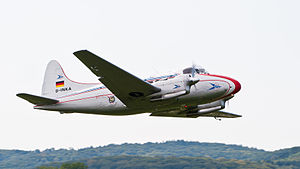De Havilland Dove
| DH.104 Dove | |
|---|---|
 |
|
| de Havilland Dove | |
| Role | short-haul airliner |
| National origin | United Kingdom |
| Manufacturer | de Havilland |
| First flight | 25 September 1945 |
| Status | Limited service |
| Produced | 1946 - 1967 |
| Number built | 542 |
| Unit cost |
$89,000 (1953)
$136,000 (1961) |
| Developed into |
de Havilland Heron de Havilland Australia DHA-3 Drover |
The de Havilland DH.104 Dove was a British short-haul airliner developed and manufactured by de Havilland. It was a monoplane successor to the prewar de Havilland Dragon Rapide biplane. The design came about from the Brabazon Committee report which, amongst other aircraft types, called for a British-designed short-haul feeder for airlines.
The Dove was a popular aircraft and is considered to be one of Britain's most successful postwar civil designs, in excess of 500 aircraft being manufactured between 1946 and 1967. Several military variants were operated, such as the Devon by the Royal Air Force, the Sea Devon by the Royal Navy and the type also saw service with a number of overseas military forces.
A longer four-engined development of the Dove, intended for use in the less developed areas of the world, was the de Havilland Heron. A considerably re-designed three-engined variant of the Dove was built in Australia as the de Havilland Australia DHA-3 Drover.
The development team for the Dove was headed by Ronald Eric Bishop, the creator of the de Havilland Mosquito, a wartime fighter-bomber, and the de Havilland Comet, the first commercial jet aircraft in the world. It had been developed to meet the Type VB requirement issued by the Brabazon Committee. In concept, the Dove was developed to be the replacement of the prewar de Havilland Dragon Rapide. It was also required to be competitive with the large numbers of surplus military transports in the aftermath of the Second World War, such as the Douglas DC-3. Unlike the Dragon Rapide, the Dove made use of a structure entirely of metal. It also featured other innovations of the time, including constant-speed propellers, flaps, and a retractable tricycle undercarriage.
...
Wikipedia
